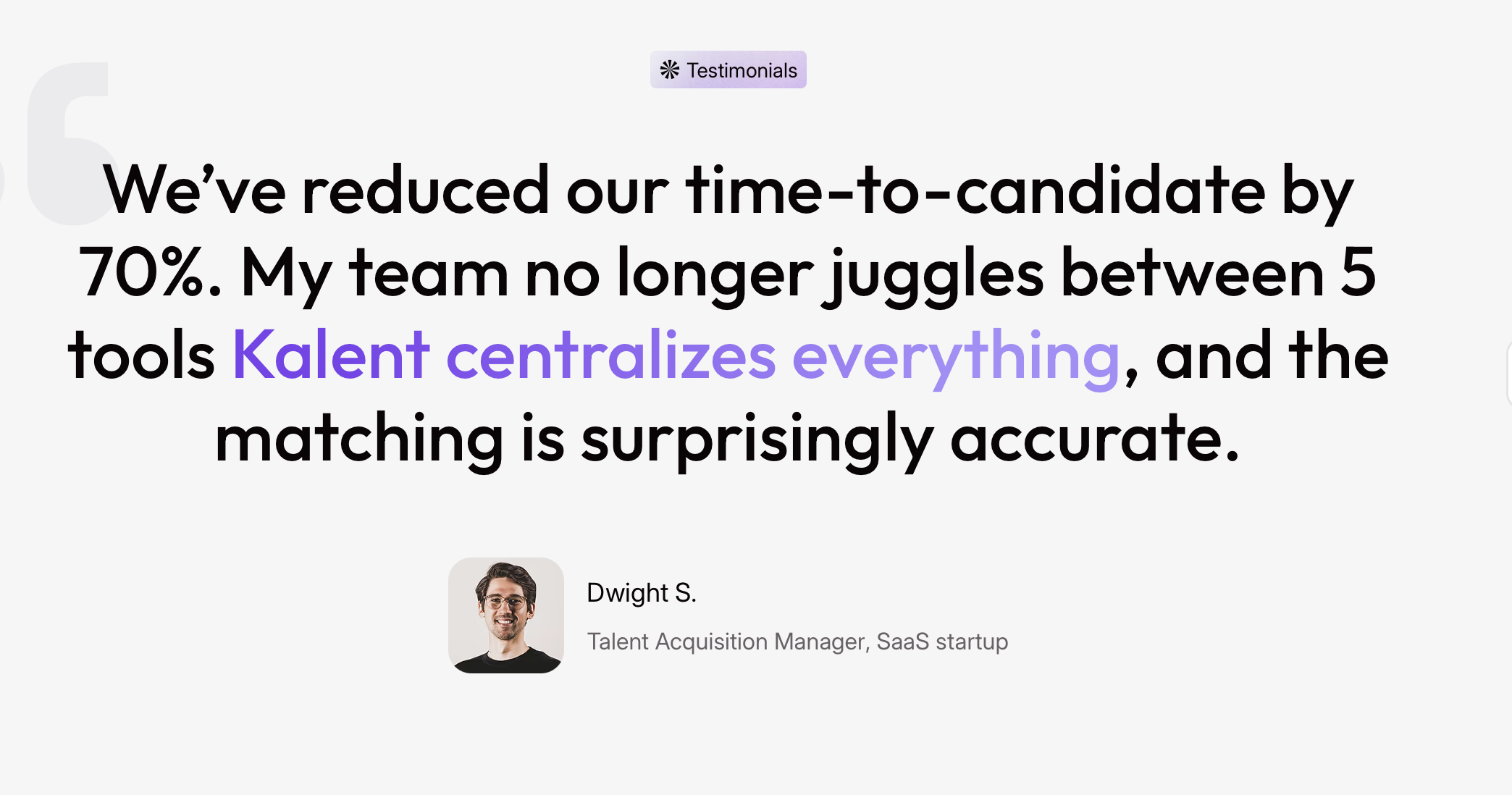What Do Talent Acquisition Jobs Look Like in 2025 and Which Tools Support Them Best?
In 2025, talent acquisition jobs have evolved beyond recruitment, blending human expertise with AI-powered tools like Kalent. This article explores how modern recruiters can adapt to new challenges, leverage contextual outreach, and boost performance through integrated technology designed to simplify workflows and increase reply rates.
What Do Talent Acquisition Jobs Look Like in 2025?
Talent acquisition jobs have changed dramatically over the past few years. In 2025, the role has evolved beyond simple recruitment and may now include other responsibilities like candidate training, performance monitoring and employer branding.
In this article, we’ll discuss the changing nature of talent acquisition jobs and what you need to do to keep up. We’ll also explore the impact of technology like AI and Easy Apply, as well as shifting roles and responsibilities for those in the talent acquisition field.
How Have Talent Acquisition Jobs Evolved in the AI Era?
Talent acquisition jobs typically involve tasks like sourcing, assessing and hiring skilled candidates for a specific company or team. Over the years, however, the role has become increasingly hybrid, blending human intuition and expertise with AI-powered insights.
While there are understandable concerns about the influx of AI on recruitment, there is no denying that the whole industry has evolved in response — to ignore this would mean getting left behind.
In the age of AI, the core skills required for modern talent acquisition jobs may now include:
Multi-Channel Outreach
This involves reaching prospective candidates across LinkedIn, email, WhatsApp and SMS/iMessage, depending on geographic rules and candidate preferences.
Data-Driven Candidate Sourcing
The most tech-savvy talent roles now use sophisticated search parameters and AI analysis to find the right people, rather than just keyword matching.
Contextual Communication
Modern talent acquisition leads will need to go a step above the norm if they want to get a candidate’s attention. Generic outreach no longer cuts it — now, you need to send personalized messages that reference specific job requirements and candidate backgrounds.
Performance Analytics
Talent acquisition professionals in 2025 need to track performance data such as reply rates, placements, ROI and time-to-hire metrics. This allows them to continuously improve and find better candidates.
Coaching and Relationship Management
These are the vital human skills that AI can't replicate, like guiding candidates through interview processes and understanding nuance.
Is AI Good or Bad for Talent Acquisition Jobs?
Just like in every other industry, there is panic about AI in the recruitment field. Candidates are wary of AI-driven processes, and recruiters are never sure whether the applications they receive are from actual people or bots.
However, the best recruiters don’t give in to this fear. Instead, they treat AI like a strategic partner rather than a threat, evolving to meet the growing needs of the market and the changing nature of their role.
AI isn’t about to take over talent acquisition jobs. Instead, it can act as a copilot, handling all the repetitive, monotonous tasks so that human experts can focus on what they do best.
What About LinkedIn Easy Apply?
The drop in candidate quality caused by mass-apply tools has undoubtedly had a negative impact on talent acquisition jobs. Now, anyone can apply to any job in a matter of minutes, meaning recruiters get flooded with irrelevant applications all day long.
On the flip side, this has actually made contextual outreach more important than ever. When hundreds of unqualified candidates can apply to a role with one click, the real competitive advantage goes to recruiters who can identify and personally engage the best talent before they even start looking at job boards. This is where AI tools like Kalent come in!

What Challenges Do Talent Acquisition Professionals Face in 2025?
Despite the promise of AI tools, talent acquisition jobs in 2025 come with significant challenges that prevent recruiters from performing at their best, and prevent candidates from finding their dream roles. These challenges include:
Low Reply Rates
The average reply rate for recruiter outreach sits at around 10-15%. That means at least 85% of the time, your carefully crafted messages get ignored. Spending time on ineffective outreach makes it nearly impossible to fill roles quickly, especially for competitive positions where speed is important. It also wastes precious time when you could be focusing on more valuable tasks like coaching candidates or getting to know your clients.
Too Many Tools
Most recruiters rely on five to six separate tools just to complete simple workflow. These tools might include LinkedIn Recruiter for sourcing, enrichment tools to find contact details, email automation platforms for outreach, a CRM to track conversations and and analytics tools to measure performance.
Each tool costs money, requires separate logins and rarely integrates seamlessly with the others. The result is a bloated tech stack that slows down processes, and recruiters who spend more time tool-switching than actually talking to candidates!
Wasted Time
Too much recruiter time goes toward administrative tasks like searching databases, copying and pasting information between platforms and manually personalizing hundreds of outreach messages. This leaves less time for what actually drives results: building relationships with candidates and understanding what clients really need.
Poor Quality Candidates
LinkedIn's Easy Apply feature has created a flood of irrelevant applications. Recruiters spend hours sifting through resumes from people who don't match the role at all, which means the truly qualified candidates (often passive candidates who aren't actively applying) get overlooked entirely.
International Hiring Challenges
For recruitment firms working across both Europe and the U.S., there's an added layer of complexity. Communication norms differ significantly across countries and regions, and email response rates vary. Managing these differences requires flexibility that most tools simply don't offer.

Kalent: the Best Platform for Modern Talent Acquisition Jobs?
Kalent is the AI-powered co-pilot built specifically for talent acquisition professionals. It's designed to address all of the challenges we mentioned above, while amplifying what recruiters do best.
Here are some of the benefits for recruiters using Kalent:
Context-Driven Matching
Unlike traditional sourcing tools that rely on basic keyword searches, Kalent integrates the full context of your job posting into both candidate search and outreach messaging.
In other words, our platform scans millions of profiles to find candidates whose experience genuinely matches what you're looking for, then crafts personalized messages that reference specific job requirements and candidate backgrounds.
This contextual approach dramatically improves both the quality of matches and the relevance of your outreach.
Multi-Channel Outreach
Kalent reaches candidates across LinkedIn, email, WhatsApp and SMS/iMessage, depending on region. This ensures you're connecting with people on the channels they actually use, increasing your chances of getting a response without feeling pushy. If a candidate doesn't respond on LinkedIn, you can follow up via email or WhatsApp without switching platforms.
Higher Reply Rates
While the industry standard is low, Kalent delivers reply rates of 30%, which is five times the industry average. Some campaigns have even reached 70-80% reply rates when recruiters optimize their messaging and timing.
Integrated All-in-One Solution
Kalent replaces five or more tools that recruiters typically need: LinkedIn Recruiter for sourcing, enrichment tools for contact data, messaging platforms for outreach, CRMs for tracking and analytics for performance measurement. Instead of paying for many expensive add-ons, you get everything you need in one integrated platform.

What Is the Future of Talent Acquisition Jobs with Kalent as a Co-Pilot?
Looking ahead, talent acquisition jobs will increasingly require recruiters to act as strategic advisors rather than administrative coordinators. Success will be measured less by ‘InMails sent’ and more by reply rates, candidate quality and actual placements made.
Kalent serves as a central platform for forward-thinking recruitment teams, consolidating sourcing, outreach, enrichment and analytics into one seamless workflow.
With support for both U.S. and European markets, Kalent allows recruiters to work across diverse geographies without managing multiple tool stacks or adapting to different communication norms manually.
The future of talent acquisition jobs is clear: fewer tools, more replies and better hires!
Recruiters who embrace AI co-pilots like Kalent will spend less time on busywork and more time doing what they were hired to do – connecting great candidates with great opportunities, and helping their clients build winning teams.
If you're ready to see how Kalent can transform your talent acquisition process, book a demo today and we’ll walk you through the exact process and tools that can 5x your response rates and help you secure stronger candidate placements.





